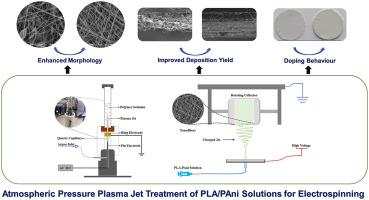Polymer ( IF 4.6 ) Pub Date : 2022-11-09 , DOI: 10.1016/j.polymer.2022.125502 Yongjian Guo , Rouba Ghobeira , Zuxin Sun , Parisa Shali , Rino Morent , Nathalie De Geyter

|
To obtain uniform and bead-free nanofibers by means of electrospinning is sometimes very challenging, especially for polymers with low solubility, such as for example the intrinsically conducting polymers (ICPs). Recently, atmospheric pressure plasma jet (APPJ) treatment to pre-electrospinning polymer solutions has been found to effectively enhance the electrospinnability of a single polymer type. Here, such an APPJ treatment has been applied for the first time to a blended polymeric solution consisting of polylactic acid (PLA) and polyaniline emeraldine base (PAni EB) as well as its emeraldine salt (ES) form doped by camphorsulfonic acid (CSA). The plasma-induced physical changes of the solutions including pH, conductivity, viscosity and surface tension have been investigated and correlated with the ensuing physicochemical properties of the electrospun nanofibers. To do so, next to the liquid-based characterizations, the nanofibers have been examined by means of scanning electron microscopy (SEM), energy dispersive X-ray spectroscopy (EDS), Fourier-transform infrared spectroscopy (FTIR), water contact angle (WCA) goniometry and uniaxial tensile testing. Results revealed that the pre-electrospinning plasma modification step resulted in a remarkably enhanced nanofiber morphology, deposition yield and mechanical performance of the electrospun nanofibers. Moreover, concomitant doping of PAni EB to PAni ES, as an unexpected side behaviour generated during the plasma treatment without the addition of any protonic acid, was found and further carefully investigated using ultraviolet/visible (UV–Vis) spectrometry. The findings obtained in this work thus enlarge the application range of pre-electrospinning APPJ treatment from single to blended polymeric solutions. Moreover, the recent pioneering discovery revealing the pre-electrospinning APPJ treatment role in enhancing electrospinning has surpassed the sole connotation of improved fiber morphology as new interesting effects are discerned in this study: boosted nanofiber deposition yield and doping capabilities.
中文翻译:

PLA/PAni 溶液的大气压等离子射流处理:增强形态,提高电纺纳米纤维的产量和伴随的掺杂行为
通过静电纺丝获得均匀且无珠的纳米纤维有时非常具有挑战性,特别是对于溶解度低的聚合物,例如本征导电聚合物 (ICPs)。最近,已发现对预静电纺丝聚合物溶液进行大气压等离子体射流 (APPJ) 处理可有效提高单一聚合物类型的静电纺丝能力。在这里,这种 APPJ 处理首次应用于由聚乳酸 (PLA) 和聚苯胺翠绿碱 (PAni EB) 及其掺杂樟脑磺酸 (CSA) 的翠蓝盐 (ES) 形式组成的混合聚合物溶液. 等离子引起的溶液物理变化,包括 pH 值、电导率、已经研究了粘度和表面张力,并将其与电纺纳米纤维的物理化学性质相关联。为此,除了基于液体的表征外,还通过扫描电子显微镜 (SEM)、能量色散 X 射线光谱 (EDS)、傅里叶变换红外光谱 (FTIR)、水接触角 ( WCA) 测角和单轴拉伸测试。结果表明,静电纺丝前等离子体改性步骤显着提高了静电纺丝纳米纤维的纳米纤维形态、沉积产率和机械性能。此外,在不添加任何质子酸的情况下,PAni EB 与 PAni ES 的同时掺杂,作为在等离子体处理过程中产生的意想不到的副作用,发现并使用紫外/可见(UV-Vis)光谱法进一步仔细研究。因此,在这项工作中获得的发现将预静电纺丝 APPJ 处理的应用范围从单一聚合物溶液扩大到混合聚合物溶液。此外,最近的开创性发现揭示了静电纺丝前 APPJ 处理在增强静电纺丝方面的作用已经超越了改善纤维形态的唯一内涵,因为在本研究中发现了新的有趣效果:提高了纳米纤维的沉积产量和掺杂能力。



























 京公网安备 11010802027423号
京公网安备 11010802027423号